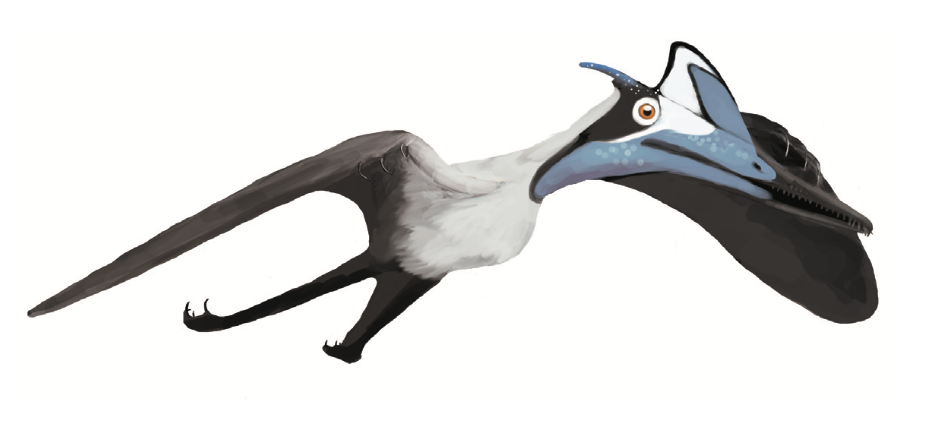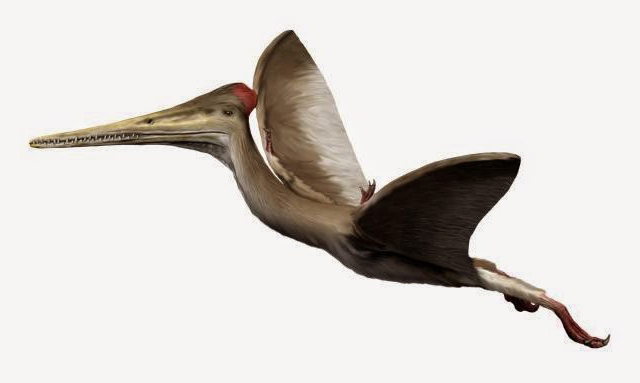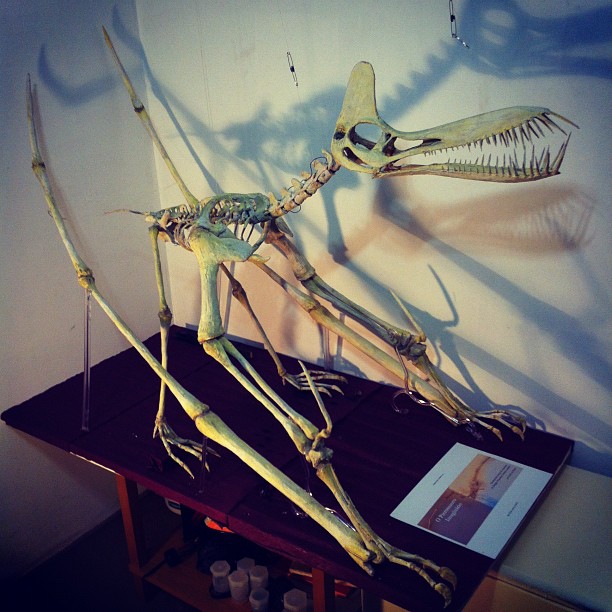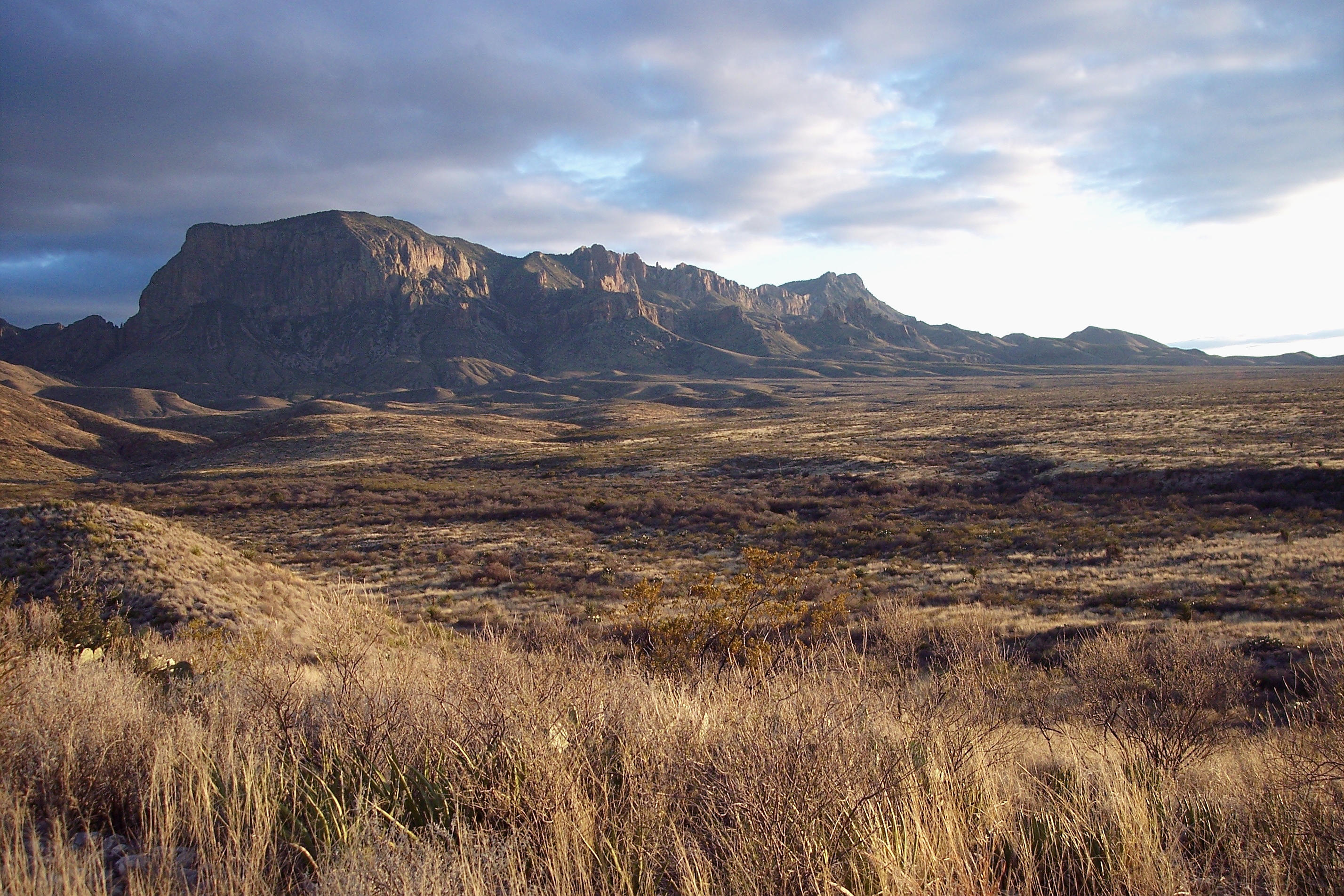|
Pterodactyloid
Pterodactyloidea ( ; derived from the Greek words ''πτερόν'' (''pterón'', for usual ''ptéryx'') "wing", and ''δάκτυλος'' (''dáktylos'') "finger") is one of the two traditional suborders of pterosaurs ("wing lizards"), and contains the most derived members of this group of flying reptiles. They appeared during the middle Jurassic Period, and differ from the basal (though paraphyletic) rhamphorhynchoids by their short tails and long wing metacarpals (hand bones). The most advanced forms also lack teeth, and by the late Cretaceous, all known pterodactyloids were toothless. Many species had well-developed crests on the skull, a form of display taken to extremes in giant-crested forms like '' Nyctosaurus'' and '' Tupandactylus''. Pterodactyloids were the last surviving pterosaurs when the order became extinct at the end of the Cretaceous Period, together with the non-avian dinosaurs and most marine reptiles. " Pterodactyl" is also a common term for pterodactyloid pte ... [...More Info...] [...Related Items...] OR: [Wikipedia] [Google] [Baidu] [Amazon] |
Pterosaur
Pterosaurs are an extinct clade of flying reptiles in the order Pterosauria. They existed during most of the Mesozoic: from the Late Triassic to the end of the Cretaceous (228 million to 66 million years ago). Pterosaurs are the earliest vertebrates known to have evolved powered flight. Their wings were formed by a membrane of skin, muscle, and other tissues stretching from the ankles to a dramatically lengthened fourth finger. There were two major types of pterosaurs. Basal pterosaurs (also called 'non-pterodactyloid pterosaurs' or ' rhamphorhynchoids') were smaller animals with fully toothed jaws and, typically, long tails. Their wide wing membranes probably included and connected the hind legs. On the ground, they would have had an awkward sprawling posture, but the anatomy of their joints and strong claws would have made them effective climbers, and some may have even lived in trees. Basal pterosaurs were insectivores or predators of small vertebrates. Later pte ... [...More Info...] [...Related Items...] OR: [Wikipedia] [Google] [Baidu] [Amazon] |
Archaeopterodactyloidea
Archaeopterodactyloidea (meaning "ancient Pterodactyloidea") is an extinct clade of pterodactyloid pterosaurs that lived from the middle Late Jurassic to the latest Early Cretaceous periods (Kimmeridgian to Albian stages) of Africa, Asia, Europe and North America. It was named by Alexander Wilhelm Armin Kellner in 1996 as the group that contains ''Germanodactylus'', ''Pterodactylus'', the Ctenochasmatidae and the Gallodactylidae. The earliest known archaeopterodactyloid remains date to the Late Jurassic Kimmeridgian age. Previously, a fossil jaw recovered from the Middle Jurassic Stonesfield Slate formation in the United Kingdom, was considered the oldest known. This specimen supposedly represented a member of the family Ctenochasmatidae, though further examination suggested it belonged to a teleosaurid crocodylomorph instead of a pterosaur. Anatomy Many archaeopterodactyloids had very distinctive features in comparison to other pterosaurs, including the shape of their jaws, a ... [...More Info...] [...Related Items...] OR: [Wikipedia] [Google] [Baidu] [Amazon] |
Azhdarchoidea
Azhdarchoidea ( , meaning "azhdarchid-like forms") is a group of pterosaurs within the suborder Pterodactyloidea. Pterosaurs belonging to this group lived throughout the Early and Late Cretaceous periods, with one tentative member, '' Tendaguripterus'', that lived in the Late Jurassic period. Remains of this group have been found in the Americas, Africa, and Eurasia, suggesting that they probably had a global distribution. Azhdarchoids are generally distinguished from other pterodactyloids by their relatively low arm-to-leg-length ratio, suggesting that they were more proficient in moving on the ground than pterosaurs like ''Pteranodon'' or '' Anhanguera'' (which had very long arms relative to the length of their legs). This has led some researchers to suggest that many azhdarchoids, such as the azhdarchids and dsungaripterids, may have been primarily terrestrial, while retaining the ability to fly when necessary. Classification Azhdarchoidea was named by paleontologist David ... [...More Info...] [...Related Items...] OR: [Wikipedia] [Google] [Baidu] [Amazon] |
Kryptodrakon
''Kryptodrakon'' is an extinct genus of pterodactyloid pterosaur from the Middle to Late Jurassic with an age of approximately 162.7 million years. It is known from a single type species, ''Kryptodrakon progenitor''. The age of its fossil remains made ''Kryptodrakon'' the basalmost and oldest pterodactyloid known to date. Discovery and naming In 2001, pterosaur bones were discovered in Xinjiang by Chris Sloan. The bones were first identified as those of a theropod; paleontologist James Clark later recognized their pterosaurian nature. In 2014, Brian Andres, Clark and Xu Xing named and described the type species ''Kryptodrakon progenitor''. The generic name means ''hidden dragon'' from Greek κρυπτός, ''kryptos'' (''hidden''), and δράκων, ''drakon'' (''dragon''). The name alludes to the film '' Crouching Tiger, Hidden Dragon,'' which included some scenes filmed near the type locality. The specific name ''progenitor'' means ''ancestor'' or ''founder of a family ... [...More Info...] [...Related Items...] OR: [Wikipedia] [Google] [Baidu] [Amazon] |
Germanodactylidae
Germanodactylidae is a controversial group of pterosaurs within the suborder Pterodactyloidea. It was first named by Yang Zhongjian in 1964, and given a formal phylogenetic definition in 2014 by Brian Andres, James Clark, and Xu Xing. They defined it as the least inclusive clade containing ''Germanodactylus cristatus'' and '' Normannognathus wellnhoferi'', which they considered to be close relatives at the time. However, more recent studies by the same researchers have found that these pterosaurs may be only distantly related. Studies performed in the 2000s suggested this group it contained three genera: ''Germanodactylus'', '' Normannognathus'' and '' Tendaguripterus''. Various studies have since placed these pterosaurs within the larger clades Archaeopterodactyloidea, Eupterodactyloidea, or Dsungaripteroidea, though it has also been recovered within the Ctenochasmatoidea. In several 2010s studies, the supposed "germanodactylid" species were not necessarily found to form a natu ... [...More Info...] [...Related Items...] OR: [Wikipedia] [Google] [Baidu] [Amazon] |
Ningchengopterus
''Ningchengopterus'' is a genus of pterodactyloid pterosaur from the Early Cretaceous period (Aptian stage). Its fossil remains were found in the Yixian Formation of what is now China. Discovery and naming It is known from a juvenile specimen, holotype CYGB-0035, an almost complete articulated skeleton of a hatchling also showing soft parts, such as the flight membrane and pycnofibres, compressed on a plate and counterplate. It was the first small toothed pterodactyloid pterosaur specimen found in China. The type species ''Ningchengopterus liuae'' was named and described by Lü Junchang in 2009. The genus name combines a reference to the Ningcheng district in Inner Mongolia with a Latinised Greek ''pteron'', "wing". The specific name honours Ms Liu Jingyi who collected the fossil and donated it to science. Description ''Ningchengopterus'' was typified by the possession of about fifty teeth, twelve in each upper jaw and thirteen in each lower jaw. The teeth are curved, conical an ... [...More Info...] [...Related Items...] OR: [Wikipedia] [Google] [Baidu] [Amazon] |
Guidraco
''Guidraco'' (Chin. ''gui'' (鬼) "malicious ghost" + Lat. ''draco'' "dragon") is an extinct genus of toothed pterodactyloid pterosaur known from the Early Cretaceous of Liaoning Province, northeast China. According to many recent studies, ''Guidraco'' is a member of the group Anhanguerinae, a subfamily belonging to the larger group Anhangueridae. Discovery ''Guidraco'' is known only from the holotype IVPP V17083, an articulated partial skeleton consisting of a nearly complete skull, lower jaws and a series of four, second to fifth, cervical vertebrae. It was collected at Sihedang near Lingyuan City in the Liaoning Province from the Jiufotang Formation, dating to the Aptian stage of the Early Cretaceous, about 120 million years ago. Etymology ''Guidraco'' was first described and named by Wang Xiaolin, Alexander W.A. Kellner, Jiang Shunxing and Cheng Xin in 2012 and the type species is ''Guidraco venator''. The generic name is derived from Chinese ''gui'' (鬼), ... [...More Info...] [...Related Items...] OR: [Wikipedia] [Google] [Baidu] [Amazon] |
Germanodactylus
''Germanodactylus'' ("German finger") is a genus of germanodactylid pterodactyloidea, pterodactyloid pterosaur from Upper Jurassic-age rocks of Germany, including the Solnhofen Limestone. Its specimens were long thought to pertain to ''Pterodactylus''. The head crest of ''Germanodactylus'' is a distinctive feature. History ''G. cristatus'' is holotype, based on specimen BSP 1892.IV.1, from the Solnhofen limestone of Eichstätt, Germany. It was originally described by Plieninger in 1901 as a specimen of ''Pterodactylus kochi'', and was given its current specific name (zoology), specific name by Carl Wiman in 1925, meaning "crested" in Latin. Yang Zhongjian determined that it deserved its own genus in 1964. A second species called ''G. ramphastinus'' (in 1858 accidentally revised to ''rhamphastinus'' by Christian Erich Hermann von Meyer) was named as a distinct species long before ''G. cristatus'', described by Johann Andreas Wagner in 1851 as a species of the now deprecated genus ... [...More Info...] [...Related Items...] OR: [Wikipedia] [Google] [Baidu] [Amazon] |
Tupandactylus
''Tupandactylus'' (meaning "Tupan finger", in reference to the Tupi thunder god) is a genus of tapejarid pterodactyloid pterosaur from the Early Cretaceous Crato Formation of Brazil. History ''Tupandactylus imperator'' is known from four nearly complete skulls. The holotype specimen is MCT 1622-R, a skull and partial lower jaw, found in the Crato Formation, dating to the boundary of the Aptian-Albian stages of the early Cretaceous period, about 112 Ma ago.Martill, D.M., Bechly, G. and Loveridge, R.F. (2007). ''The Crato fossil beds of Brazil: window into an ancient world.'' Cambridge University Press. , It was initially described as a species of '' Tapejara'', but later research has indicated it warrants its own genus. The skull was toothless and had a prominent sagittal crest, only the base of which was bony: the front of the crest featured a tall bony rod extending up and back, and the rear of the crest had a long prong of bone projecting behind it. The bulk of the crest w ... [...More Info...] [...Related Items...] OR: [Wikipedia] [Google] [Baidu] [Amazon] |
Quetzalcoatlus
''Quetzalcoatlus'' () is a genus of azhdarchid pterosaur that lived during the Maastrichtian age of the Late Cretaceous in North America. The Type (biology), type specimen, recovered in 1971 from the Javelina Formation of Texas, United States, consists of several wing fragments and was species description, described as ''Quetzalcoatlus northropi'' in 1975 by Douglas A. Lawson, Douglas Lawson. The Generic name (biology), first part of the name refers to the Aztec serpent god of the sky, Quetzalcōātl, while the specific name, second part honors Jack Northrop, designer of a flying wing, tailless fixed-wing aircraft. The remains of a second species were found between 1972 and 1974, also by Lawson, around from the ''Q. northropi'' locality. In 2021, these remains were assigned to the name ''Quetzalcoatlus lawsoni'' by Brian Andres and (posthumously) Wann Langston Jr., Wann Langston Jr, as part of a series of publications on the genus. ''Quetzalcoatlus northropi'' has gained fame a ... [...More Info...] [...Related Items...] OR: [Wikipedia] [Google] [Baidu] [Amazon] |
Dermodactylus
''Dermodactylus'' (meaning "skin finger", from Greek ''derma'' and ''daktylos'', in reference to pterosaur wings being skin membranes supported by the ring fingers) was a genus of pterodactyloid (general term for "short-tailed" pterosaur) pterosaur from the Kimmeridgian-Tithonian-age Upper Jurassic Morrison Formation of Wyoming, United States. It is based on a single partial bone, from the hand. History and classification ''Dermodactylus'' is based on a single distal right fourth metacarpal found by Samuel Wendell Williston at Como Bluff, Wyoming in 1878; this bone is currently housed in the collections of the Yale Peabody Museum of Natural History in New Haven, Connecticut (YPM 2020YPM=Yale University Peabody Museum of Natural History, New Haven, Connecticut.). This bone constituted at the time the oldest pterosaur remains found, recognized, and described from North America. Othniel Charles Marsh first named it as a species of ''Pterodactylus'': ''P. montanus'', the specific na ... [...More Info...] [...Related Items...] OR: [Wikipedia] [Google] [Baidu] [Amazon] |
Pangupterus
''Pangupterus'' (meaning Pangu wing) is a genus of pterodactyloid pterosaur from the Early Cretaceous Jiufotang Formation of China. It was first described and named by Lü Junchang ''et al''. It is known from a mostly-complete lower jaw, which bears 36 slender, evenly-spaced, conical teeth jutting out at an angle on its tip. Some teeth are smaller than the others, and appear to be replacement teeth. The teeth had a relatively high density of over , although the spaces between the teeth were wider than the diameter of the teeth themselves. Such teeth are not seen in any other toothed pterosaurs from the Jiufotang Formation with comparable material, and this specialized dental morphology is indicative of a piscivorous lifestyle. Although no phylogenetic analysis was conducted to determine its affinities, ''Pangupterus'' has a small process, called an odontoid, on the end of the maxilla; such a process is also seen in the istiodactylids '' Longchengpterus'' and ''Istiodactylus''. I ... [...More Info...] [...Related Items...] OR: [Wikipedia] [Google] [Baidu] [Amazon] |







